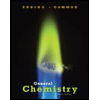
Chemistry
4th Edition
ISBN: 9780078021527
Author: Julia Burdge
Publisher: McGraw-Hill Education
expand_more
expand_more
format_list_bulleted
Question
Chapter 14, Problem 79AP
Interpretation Introduction
Interpretation:
Thehalf-life of the reaction is to be determined graphically.
Concept Introduction:
The half-life of a reaction is defined as the time required for the reactant concentration to decrease to half of its initial value, and it is denoted by the symbol
Expert Solution & Answer
Want to see the full answer?
Check out a sample textbook solution
Students have asked these similar questions
For the following alkyne, complete the reaction sequentially (that is draw the intermediate that we can’t stop at) and then name (complete name) all 3 molecules.
Given the reaction sequence below, answer the following.
A. Provide the structure for A.
B. Provide the structure for B (pay attention to stereochemistry).
C. Provide the structure for C.
D. What are the stereochemical designations for I and II (R/S)?
Which of the following is the most stable carbon radical?
Chapter 14 Solutions
Chemistry
Ch. 14.1 - Practice Problem ATTEMPT
Write the rate...Ch. 14.1 - Practice ProblemBUILD Write the balanced equation...Ch. 14.1 - Prob. 1PPCCh. 14.1 - 14.1.1 Which expressions are correct for the rate...Ch. 14.1 - 14.1.2 In the same reaction:
if the concentration...Ch. 14.2 - Practice Problem ATTEMPT Consider the reaction:...Ch. 14.2 - Practice Problem BUILD Consider the following...Ch. 14.2 - Practice Problem CONCEPTUALIZE
Consider the...Ch. 14.2 - Answer questions 14.2.1 through 14.2.4 using the...Ch. 14.2 - Answer questions 14.2.1 through 14.2.4 using the...
Ch. 14.2 - Answer questions 14.2.1 through 14.2.4 using the...Ch. 14.2 - Answer questions 14.2.1 through 14.2.4 using the...Ch. 14.2 - 14.2.5 The diagrams represent three experiments in...Ch. 14.3 - Prob. 1PPACh. 14.3 - Practice Problem BUILD
For the following general...Ch. 14.3 - Practice Problem CONCEPTUALIZE
Three initial-rate...Ch. 14.3 - The first-order decomposition of dinitrogen...Ch. 14.3 - The first-order decomposition of dinitrogen...Ch. 14.3 - 14.3.3 Consider the first-order reaction in which...Ch. 14.3 - Which figure below represents the numbers of...Ch. 14.3 - 14.3.5 Of the plots shown here, ___________...Ch. 14.4 - Practice Problem ATTEMPT
The rate constant for the...Ch. 14.4 - Practice Problem BUILD
Refer again to the reaction...Ch. 14.4 - Practice Problem CONCEPTUALIZE
The diagrams on...Ch. 14.4 - Use the table of data collected for a first-order...Ch. 14.4 - Prob. 2CPCh. 14.4 - Prob. 3CPCh. 14.5 - Practice Problem ATTEMPT Ethyl iodide ( C 2 H 5 I)...Ch. 14.5 - Practice Problem BUILD Use the calculated k from...Ch. 14.5 - Practice Problem CONCEPTUALIZE
Use the graph in...Ch. 14.5 - Use the following information to answer questions...Ch. 14.5 - Use the following information to answer questions...Ch. 14.5 - Use the following information to answer questions...Ch. 14.5 - 14.5.4 A plausible mechanism for the reaction:
Ch. 14.6 - Practice ProblemATTEMPT Calculate the half-life of...Ch. 14.6 - Practice ProblemBUILD Calculate the rate constant...Ch. 14.6 - Practice Problem CONCEPTUALIZE
The diagrams show a...Ch. 14.7 - Practice Problem ATTEMPT
The reaction is second...Ch. 14.7 - Practice Problem BUILD
Determine the initial...Ch. 14.7 - Practice ProblemCONCEPTUALIZE The diagrams below...Ch. 14.8 - Practice ProblemATTEMPT The second-order rate...Ch. 14.8 - Practice Problem BUILD Use the graph to determine...Ch. 14.8 - Prob. 1PPCCh. 14.9 - Practice ProblemATTEMPT Use the data in the...Ch. 14.9 - Practice ProblemBUILD Based on the data shown in...Ch. 14.9 - Practice Problem CONCEPTUALIZE
According to the...Ch. 14.10 - Practice ProblemATTEMPT Calculate the rate...Ch. 14.10 - Practice ProblemBUILD Calculate the rate constant...Ch. 14.10 - Practice ProblemCONCEPTUALIZE According to the...Ch. 14.11 - Practice Problem ATTEMPT
The reaction between and...Ch. 14.11 - Practice ProblemBUILD Propose a plausible...Ch. 14.11 - Practice Problem CONCEPTUALIZE
How many steps are...Ch. 14.12 - Practice Problem ATTEMPT
Show that the following...Ch. 14.12 - Practice Problem BUILD
The reaction proceeds via...Ch. 14.12 - Practice Problem CONCEPTUALIZE
The reaction of is...Ch. 14 - Prob. 1KSPCh. 14 - Prob. 2KSPCh. 14 - Prob. 3KSPCh. 14 - Prob. 4KSPCh. 14 - 14.1 What is meant by the rate of a chemical...Ch. 14 - Distinguish between average rate and instantaneous...Ch. 14 - What are the advantages of measuring the initial...Ch. 14 - Identify two reactions that are very slow (take...Ch. 14 - Write the reaction rate expressions for the...Ch. 14 - Write the reaction rate expressions for the...Ch. 14 - Consider the reaction: 2NO ( g ) + O 2 ( g ) → 2NO...Ch. 14 - 14.8 Consider the reaction:
Suppose that at a...Ch. 14 - 14.9 Explain what is meant by the rate law of a...Ch. 14 - Prob. 10QPCh. 14 - What are the units for the rate constants of...Ch. 14 - 14.12 Consider the zeroth-order reaction: a ...Ch. 14 - 14.13 The rate constant of a first-order reaction...Ch. 14 - Identify two reactions that are very slow (take...Ch. 14 - The rate law for the reaction: N H 4 + ( a q )+N O...Ch. 14 - Use the data in Table 14.2 to calculate the rate...Ch. 14 - 14.17 Consider the reaction:
From the following...Ch. 14 - Consider the reaction: X + Y → Z From the...Ch. 14 - Determine the overall orders of the reactions to...Ch. 14 - 14.20 Consider the reaction:
The rate of the...Ch. 14 - Cyclobutane decomposes to ethylene according to...Ch. 14 - The following gas-phase reaction was studied at...Ch. 14 - Write an equation relating the concentration of a...Ch. 14 - 14.24 Define half-life. Write the equation...Ch. 14 - Prob. 25QPCh. 14 - 14.26 For a first-order reaction, how long will it...Ch. 14 - What is the half-life of a compound if 75 percent...Ch. 14 - 14.28 The thermal decomposition of phosphine into...Ch. 14 - The rate constant for the second-order reaction:...Ch. 14 - The rate constant for the second-order reaction:...Ch. 14 - 14.31 The second-order rate constant for the...Ch. 14 - Prob. 32QPCh. 14 - 14.33 The reaction shown here follows first-order...Ch. 14 - 14 34 Define activation energy. What role does...Ch. 14 - Prob. 35QPCh. 14 - Prob. 36QPCh. 14 - The burning of methane in oxygen is a highly...Ch. 14 - Sketch a potential-energy versus reaction progress...Ch. 14 - The reaction H+H 2 → H 2 +H has been studied for...Ch. 14 - Over the range of about ±3°C from normal body...Ch. 14 - For the reaction: NO ( g ) + O 3 ( g ) → NO 2 ( g...Ch. 14 - The rate constant of a first-order reaction is 4...Ch. 14 - The rate constants of some reactions double with...Ch. 14 - 14.44 The rate at which tree crickets chirp is ...Ch. 14 - The rate of bacterial hydrolysis of fish muscle is...Ch. 14 - Prob. 46QPCh. 14 - Given the same reactant concentrations, the...Ch. 14 - 14.48 Variation of the rate constant with...Ch. 14 - 14.49 Diagram A describes the initial state of...Ch. 14 - 14 50 What do we mean by the mechanism of a...Ch. 14 - 14.51 What is an elementary step? What is the...Ch. 14 - 14.52 Classify the following elementary reactions...Ch. 14 - Reactions can be classified as unimolecular,...Ch. 14 - Determine the molecularity, and write the rate law...Ch. 14 - 14.55 What is the rate-determining step of a...Ch. 14 - 14.56 The equation for the combustion of ethane ...Ch. 14 - Specify which of the following species cannot be...Ch. 14 - Classify each of the following elementary steps as...Ch. 14 - 14.59 The rate law for the reaction:
is given by...Ch. 14 - For the reaction x 2 + y + z → x y + x z , it is...Ch. 14 - The rate law for the reaction: 2H 2 ( g ) + 2NO (...Ch. 14 - 14.62 The rate law for the decomposition of ozone...Ch. 14 - 14.63 How does a catalyst increase the rate of a...Ch. 14 - 14.64 What are the characteristics of a...Ch. 14 - A certain reaction is known to proceed slowly at...Ch. 14 - Most reactions, including enzyme-catalyzed...Ch. 14 - 14.67 Are enzyme-catalyzed reactions examples of...Ch. 14 - The concentrations of enzymes in cells are usually...Ch. 14 - When fruits such as apples and pears are cut. the...Ch. 14 - The first-order rate constant for the dehydration...Ch. 14 - Which two potential-energy profiles represent the...Ch. 14 - Consider the following mechanism for the...Ch. 14 - List four factors that influence the rate of a...Ch. 14 - 14.71 Suggest experimental means by which the...Ch. 14 - 14.75 “The rate constant for the reaction:
is .”...Ch. 14 - Prob. 76APCh. 14 - The following diagrams represent the progress of...Ch. 14 - The following diagrams show the progress of the...Ch. 14 - Prob. 79APCh. 14 - Prob. 80APCh. 14 - 14.81 When methyl phosphate is heated in acid...Ch. 14 - The rate of the reaction: CH 3 COOC 2 H 5 ( a q )...Ch. 14 - Explain why most metals used in catalysis are...Ch. 14 - Prob. 84APCh. 14 - The bromination of acetone is acid-catalyzed: CH 3...Ch. 14 - The decomposition of N 2 O to N 2 and O 2 is a...Ch. 14 - 14.87 The reaction proceeds slowly in aqueous...Ch. 14 - Prob. 88APCh. 14 - The integrated rate law for the zeroth-order...Ch. 14 - 14.90 A flask contains a mixture of compounds A...Ch. 14 - Prob. 91APCh. 14 - 14.92 The rate law for the reaction . Which of the...Ch. 14 - 14.93 The reaction of to form 2EG is exothermic,...Ch. 14 - 14.94 The activation energy for the decomposition...Ch. 14 - Prob. 95APCh. 14 - 14.96 When 6 g of granulated Zn is added to a...Ch. 14 - Prob. 97APCh. 14 - 14.98 A certain first-order reaction is 35.5...Ch. 14 - 14.99 The decomposition of dinitrogen pentoxide...Ch. 14 - 14.100 The thermal decomposition of obeys...Ch. 14 - 14.101 When a mixture of methane and bromine is...Ch. 14 - 14.102 The rate of the reaction between to form...Ch. 14 - The rate constant for the gaseous reaction: H 2 (...Ch. 14 - A gas mixture containing CH 3 fragments. C 2 H 6...Ch. 14 - Consider the following elementary step: X + 2Y →...Ch. 14 - 14.106 The following scheme in which A is...Ch. 14 - 14.107 (a) Consider two reactions, A and B. If the...Ch. 14 - The rate law for the following reaction: CO ( g )...Ch. 14 - Consider the following elementary steps for a...Ch. 14 - Prob. 110APCh. 14 - Consider the following potential-energy profile...Ch. 14 - The rate of a reaction was followed by the...Ch. 14 - 14.113 The first-order rate constant for the...Ch. 14 - 14.114 Many reactions involving heterogeneous...Ch. 14 - Thallium(I) is oxidized by cerium(IV) as follows:...Ch. 14 - The activation energy for the reaction: N 2 O ( g...Ch. 14 - Δ H ° for the reaction in Problem 14.116 is -164...Ch. 14 - 14.118 At a certain elevated temperature, ammonia...Ch. 14 - 14.119 The following expression shows the...Ch. 14 - In a certain industrial process involving a...Ch. 14 - Strontium-90, a radioactive isotope, is a major...Ch. 14 - Prob. 122APCh. 14 - Prob. 123APCh. 14 - A factory that specializes in the refinement of...Ch. 14 - 14.125 When the concentration of A in the reaction...Ch. 14 - 14.126 The activity of a radioactive sample is the...Ch. 14 - Prob. 127APCh. 14 - Prob. 128APCh. 14 - Prob. 129APCh. 14 - Prob. 130APCh. 14 - Prob. 131APCh. 14 - Prob. 132APCh. 14 - Prob. 133APCh. 14 - 14.134 At a certain elevated temperature, ammonia...Ch. 14 - Polyethylene is used in many items, including...Ch. 14 - In recent years, ozone in the stratosphere has...Ch. 14 - Metastron, an aqueous solution of 89 SrCl 2 , is a...Ch. 14 - Metastron, an aqueous solution of 89 SrCl 2 , is a...Ch. 14 - Metastron, an aqueous solution of 89 SrCl 2 , is a...Ch. 14 - Metastron, an aqueous solution of 89 SrCl 2 , is a...
Knowledge Booster
Similar questions
- Put the following carbon radicals in order of increasing stability.arrow_forwardDraw the major organic product for each of the following reactions (pay attention to stereochemistry).arrow_forwardThere are 2 reactions (that you know of) to achieve the following transformation: One reaction is favored over the other because it avoids a competing reaction. A. Draw the favored reaction scheme (not the mechanism), be sure to include all necessary reagents. B. Draw the reaction scheme that is not favored and include all the possible products.arrow_forward
- Both carbocations and carbon-radicals have trigonal planar geometry. True or Falsearrow_forwardTeflon (polytetrafluoroethene) is prepared via the radial polymerization of tetrafluoroethene. What other reaction conditions (reagent, etc.) are needed to accomplish this? A. NBS, Light B. Heat, Cl2 C. Peroxide, Heat D. H2SO4, H2O, Heatarrow_forwardWhich of the following compounds can be reacted with ethene to prepare 1,1- dichlorocyclopropane? A. CCl4 B. CCl2 C. CHCl3 D. CH2Cl2arrow_forward
- CI 4. How are the products of the following reaction related? (assuming we can control the chlorination as given by the reaction) C Cl2, light A. Enantiomers B. Constitutional isomers C. Regioisomers D. Diastereomers C +arrow_forwardVinyl and allyl radicals are equally stable due to resonance stabilization True OR Falsearrow_forwardAll of the following are true of Markovnikov’s rule EXCEPT A. The nucleophile adds to the most substituted carbon B. The more stable carbocation is formed in the transition state C. The electrophile adds to the carbon that has the most hydrogens D. There are no exceptions to this rulearrow_forward
arrow_back_ios
SEE MORE QUESTIONS
arrow_forward_ios
Recommended textbooks for you
 Physical ChemistryChemistryISBN:9781133958437Author:Ball, David W. (david Warren), BAER, TomasPublisher:Wadsworth Cengage Learning,
Physical ChemistryChemistryISBN:9781133958437Author:Ball, David W. (david Warren), BAER, TomasPublisher:Wadsworth Cengage Learning, ChemistryChemistryISBN:9781305957404Author:Steven S. Zumdahl, Susan A. Zumdahl, Donald J. DeCostePublisher:Cengage Learning
ChemistryChemistryISBN:9781305957404Author:Steven S. Zumdahl, Susan A. Zumdahl, Donald J. DeCostePublisher:Cengage Learning
 Chemistry: Principles and PracticeChemistryISBN:9780534420123Author:Daniel L. Reger, Scott R. Goode, David W. Ball, Edward MercerPublisher:Cengage Learning
Chemistry: Principles and PracticeChemistryISBN:9780534420123Author:Daniel L. Reger, Scott R. Goode, David W. Ball, Edward MercerPublisher:Cengage Learning General Chemistry - Standalone book (MindTap Cour...ChemistryISBN:9781305580343Author:Steven D. Gammon, Ebbing, Darrell Ebbing, Steven D., Darrell; Gammon, Darrell Ebbing; Steven D. Gammon, Darrell D.; Gammon, Ebbing; Steven D. Gammon; DarrellPublisher:Cengage Learning
General Chemistry - Standalone book (MindTap Cour...ChemistryISBN:9781305580343Author:Steven D. Gammon, Ebbing, Darrell Ebbing, Steven D., Darrell; Gammon, Darrell Ebbing; Steven D. Gammon, Darrell D.; Gammon, Ebbing; Steven D. Gammon; DarrellPublisher:Cengage Learning Chemistry for Engineering StudentsChemistryISBN:9781337398909Author:Lawrence S. Brown, Tom HolmePublisher:Cengage Learning
Chemistry for Engineering StudentsChemistryISBN:9781337398909Author:Lawrence S. Brown, Tom HolmePublisher:Cengage Learning

Physical Chemistry
Chemistry
ISBN:9781133958437
Author:Ball, David W. (david Warren), BAER, Tomas
Publisher:Wadsworth Cengage Learning,

Chemistry
Chemistry
ISBN:9781305957404
Author:Steven S. Zumdahl, Susan A. Zumdahl, Donald J. DeCoste
Publisher:Cengage Learning


Chemistry: Principles and Practice
Chemistry
ISBN:9780534420123
Author:Daniel L. Reger, Scott R. Goode, David W. Ball, Edward Mercer
Publisher:Cengage Learning

General Chemistry - Standalone book (MindTap Cour...
Chemistry
ISBN:9781305580343
Author:Steven D. Gammon, Ebbing, Darrell Ebbing, Steven D., Darrell; Gammon, Darrell Ebbing; Steven D. Gammon, Darrell D.; Gammon, Ebbing; Steven D. Gammon; Darrell
Publisher:Cengage Learning

Chemistry for Engineering Students
Chemistry
ISBN:9781337398909
Author:Lawrence S. Brown, Tom Holme
Publisher:Cengage Learning